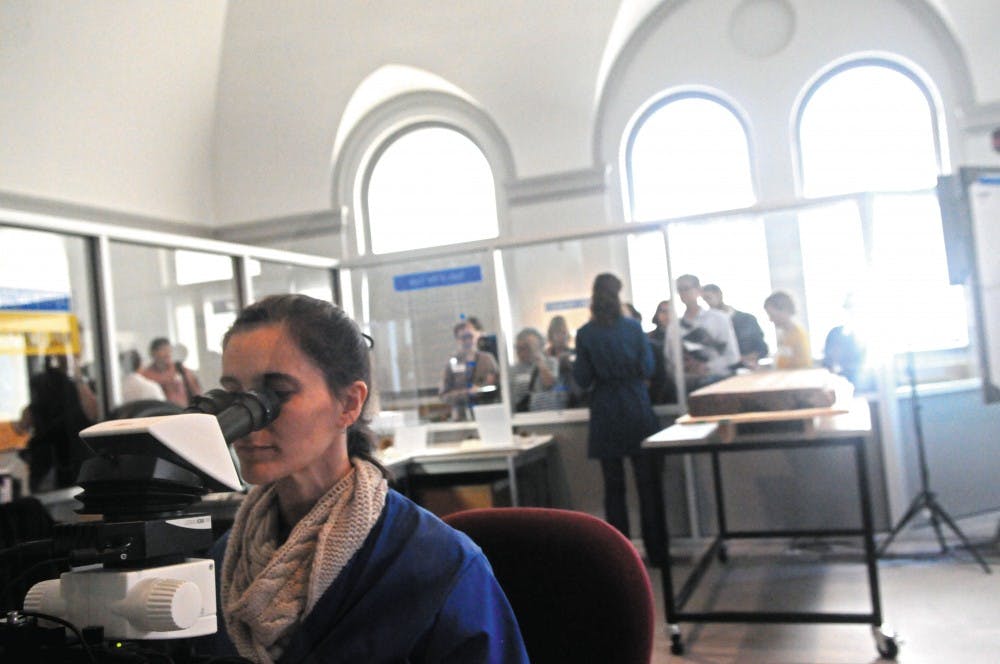
Molly Gleeson stood over a coffin from 558 B.C. Removed from the grave well over 100 years ago, this coffin had damage. The flaky paint, loose wood and large cracks all needed to be fixed before the piece can go on exhibit at the Penn Museum.
A conservator at the museum, Gleeson is one of several who is a part of the museum’s new exhibit, “In the Artifact Lab: Conserving Egyptian Mummies.” She works inside a glass-enclosed lab restoring ancient Egyptian artifacts as old as 4,000 years, while visitors can observe from the other side.
On Friday, about 25 members of the media gathered on the third floor of the museum to catch a glimpse of the new exhibit, which has now been open to the public for about three weeks. Photographers, videographers and reporters filled the exhibit space.
Penn Museum Director Julian Siggers said this new exhibit “demonstrates the work done behind the walls” and is a “wonderful opportunity for the public to see the research that goes on here.”
This evolving project seeks to inform the public about conservation, work usually done behind the scenes.
Along with the 15 artifacts within the lab — which include mummified humans and animals — there are 12 on display around the room. Those on display have special conservation stories, which list their status as treated or untreated and what the conservators did to the particular object.
Some artifacts cannot be exhibited in their current condition and therefore need treatment by the conservators. The lab contains state-of-the-art technology, including microscopes, a filtered vacuum, light sources and various other tools to ensure proper care is given to each artifact.
Gleeson, along with other members of the conservation department, opens the glass panels of the lab to speak to the public twice a day. Question and answer periods occur at 11:15 a.m. and 2 p.m. from Tuesday through Friday, and at 1 p.m. and 3:30 p.m. on weekends.
“I’ve always been drawn to projects that develop public outreach, and it’s a big reason why I wanted to work on this project,” Gleeson said. She said she looks forward to speaking to the public about her work. “It’s energizing to talk to the public … and people ask me really interesting questions — things that I hadn’t thought about.”
When the conservators are unavailable for questioning, a SMART Board is updated with information about their current project. The exhibit also contains interactive stations, including a screen that displays what the conservators are viewing under the microscope, and materials that visitors can feel to discover the textures of mummified skin and mummy bandages.
In addition to the coffin Gleeson worked on, other artifacts under conservation include 4,000-year-old coffin boards from the inner coffin of an Egyptian man named Ahanakht. The wooden boards feature carved texts in hieroglyphs that were previously unreadable without the new exhibit space. David Silverman, curator of the Egyptian section said, “I started working on this more than a decade ago, but because of the condition where we have to look at it — [it] was impossible to work with. Plus, it had to be stabilized.”
Within the new exhibit space, Silverman, along with a Penn graduate student, can begin examining and deciphering the text, some of which has never been seen before.
“In the Artifact Lab” gives the public opportunities to learn more about and explore the depths of Egypt’s vast culture.
“When you go to a museum, sometimes you can read about how the material was discovered, when it was discovered and [when] it comes here. Then the next time you know anything about it, it’s out there [on exhibit],” Silverman said. “So what we’re doing is the transition period — what we do with the material to make it possible to learn all the information so that when we want to put it on exhibit, we can.”
The Daily Pennsylvanian is an independent, student-run newspaper. Please consider making a donation to support the coverage that shapes the University. Your generosity ensures a future of strong journalism at Penn.
DonatePlease note All comments are eligible for publication in The Daily Pennsylvanian.





